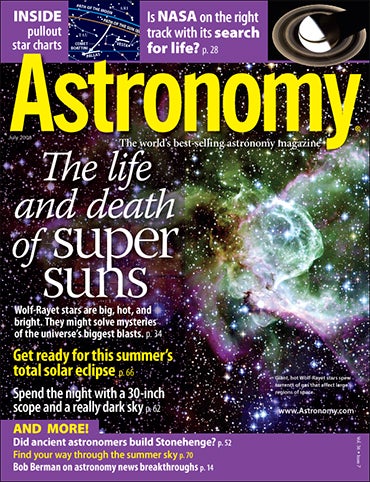
More resources from Astronomy.com:
- Astronomy news
- Astronomy basics
- Glossary of astronomical terms
- Return to Astronomy “For the media” page
Astronomy‘s mission:
Astronomy promotes the science and hobby of astronomy through high-quality publications that engage, inform, entertain, and inspire.
Waukesha, Wis. — Summer is the best time to observe the wonders of the night sky. For the next few months, lots of bright stars will be visible, making it easy to find celestial objects.
“Find your way through the summer sky,” by Astronomy Senior Editor Michael E. Bakich, guides an introductory tour of constellations, stars, and the Milky Way. Readers will be able to spend their summer nights observing with friends and family.
The issue also includes a star map that showcases the summer sky and highlights observable constellations.
“The life and death of super suns”
Wolf-Rayet stars are extremely hot and luminous celestial objects. They release so much heat and light that their outer gas shells flee from the rest of the star.
For many people, old age is a time of declining vitality. We become less energetic, more sedentary. Not so for big stars. When a massive star becomes a senior citizen, it starts acting like a badly behaved teenager: loud and aggressive, prone to sudden outbursts, and apt to wreak havoc on everything in the neighborhood.
The lifespan of Wolf-Rayet stars is normally less than 1 million years and ends in a huge explosion — a supernova. Understanding how these stars die could tell astronomers what triggers such an explosion.
“The life and death of super suns,” by Robert Zimmerman, goes deep inside the universe’s biggest blasts.
Robert Zimmerman is a frequent contributor to Astronomy. His latest book is The Universe in a Mirror: The Saga of the Hubble Space Telescope and the Visionaries Who Built It.
“Get ready for summer’s total solar eclipse”
August 1 marks the date of this century’s sixth total solar eclipse. This eclipse occurs when the Moon slowly covers the Sun, turning daylight to dusk for as long as 2.5 minutes. Observers along a slim path from northern Canada to China will see the total eclipse. People in most of Europe and Asia will see a partial one. “Get ready for summer’s total solar eclipse,” by Senior Editor Michael E. Bakich, tells you everything you need to know to observe this spectacular sky event.
“Did ancient astronomers build Stonehenge?”
Stonehenge, located between the hills of England’s Salisbury Plain, was built almost 5,000 years ago. This Neolithic monument often shows signs of astronomical alignments. “Did ancient astronomers build Stonehenge?”, by Dan Falk, questions how many of these alignments were purposely built into the ancient structure.
Dan Falk is a science journalist based in Toronto and author of In Search of Time: The Science of a Curious Dimension, which will be published this fall.
July night sky events visible without optical aid
July 15 — Saturn and Mars are in conjunction mid-month
July 27 — Look for fireworks from the Aquarius meteor shower
Also in the July 2008 Astronomy
- “Observing the way it was meant to be” — Read what Senior Editor Michael E. Bakich observed during his stay at Arizona Sky Village.
- “Are we looking for life in the right places?” — Scientists believe fluids other than water could be the key to finding life on other worlds.
- “The sky this month” — Exclusive pullout star charts will guide you through July’s night sky.
- The July issue of Astronomy also includes Astro news, Bob Berman’s strange universe, Glenn Chaple’s observing basics, Phil Harrington’s binocular universe, Stephen James O’Meara’s secret sky, New products, and Reader gallery.









